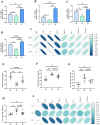Dietary Epidermal Growth Factor Supplementation Alleviates Intestinal Injury in Piglets with Intrauterine Growth Retardation via Reducing Oxidative Stress and Enhancing Intestinal Glucose Transport and Barrier Function
- PMID: 36077965
- PMCID: PMC9454730
- DOI: 10.3390/ani12172245
Dietary Epidermal Growth Factor Supplementation Alleviates Intestinal Injury in Piglets with Intrauterine Growth Retardation via Reducing Oxidative Stress and Enhancing Intestinal Glucose Transport and Barrier Function
Abstract
EGF plays an important role in the intestinal repair and nutrients transport of animals. However, the effect of EGF on the intestinal health of piglets with IUGR has not been reported. Thus, the present study was performed to investigate the effects of EGF on the intestinal morphology, glucose absorption, antioxidant capacity, and barrier function of piglets with IUGR. A total of 6 NBW piglets and 12 IUGR piglets were randomly divided into three treatments: NC group (NBW piglets fed with basal diet, n = 6), IC group (IUGR piglets fed with basal diet, n = 6), and IE group (IUGR piglets fed with basal diet supplemented with 2 mg/kg EGF, n = 6). Growth performance, serum biochemical profile, jejunum histomorphology, jejunum glucose absorption and antioxidant capacity, and jejunal barrier function were measured. The results showed that EGF supplementation significantly increased the final body weight (FBW), average daily gain (ADG), and average daily feed intake (ADFI) of piglets with IUGR; EGF supplementation significantly increased the total protein (TP), glucose (GLU), and immunoglobulin G (IgG) levels compared with the IUGR piglets in the IC group; EGF administration effectively exhibited an increased jejunum villus height (VH) and the villus-height-to-crypt-depth ratio (V/C) of IUGR piglets compared with the IC group; EGF supplementation significantly increased sodium/potassium-transporting adenosine triphosphatase (Na+/K+-ATPase) activity, intestinal alkaline phosphatase (AKP) activity, glucose transporter sodium/glucose cotransporter 1 (SGLT1), glucose transporter 2 (GLUT2), and AMP-activated protein kinase α1 (AMPK-α1) mRNA expressions in the jejunum of IUGR piglets compared with the IC group; EGF supplementation exhibited increased superoxide dismutase (SOD) activity and total antioxidant capacity (T-AOC) levels, tended to increase glutathione peroxidase (GSH-Px) and catalase (CAT) activities, and tended to decrease the malondialdehyde (MDA) level in the jejunum of IUGR piglets compared with the IC group; EGF supplementation significantly increased ZO-1, Claudin-1, Occludin, and MUC2 mRNA expressions and improved secreted immunoglobulin A (sIgA) secretion in the jejunum of IUGR piglets compared with the IC group and tended to decrease the interleukin 1β (IL-1β), IL-6, and tumor necrosis factor α (TNF-α) levels in the jejunum of IUGR piglets compared with the IC group. Pearson's correlation analysis further showed that EGF can promote intestinal development and nutrient absorption by promoting intestinal barrier function, thus improving the growth performance of IUGR piglets.
Keywords: epidermal growth factor; glucose absorption; intestinal barrier function; intrauterine growth retardation; oxidative stress; piglets.
Conflict of interest statement
The authors declare no conflict of interest.
Figures





Similar articles
-
Effects of dietary epidermal growth factor supplementation on liver antioxidant capacity of piglets with intrauterine growth retardation.J Anim Sci. 2023 Jan 3;101:skad323. doi: 10.1093/jas/skad323. J Anim Sci. 2023. PMID: 37812936 Free PMC article.
-
Effects of Equol Supplementation on Growth Performance, Redox Status, Intestinal Health and Skeletal Muscle Development of Weanling Piglets with Intrauterine Growth Retardation.Animals (Basel). 2023 Apr 26;13(9):1469. doi: 10.3390/ani13091469. Animals (Basel). 2023. PMID: 37174509 Free PMC article.
-
Dietary supplementation with dihydroartemisinin improves intestinal barrier function in weaned piglets with intrauterine growth retardation by modulating the gut microbiota.J Anim Sci. 2024 Jan 3;102:skae140. doi: 10.1093/jas/skae140. J Anim Sci. 2024. PMID: 38813622 Free PMC article.
-
Maternal imprinting of the neonatal microbiota colonization in intrauterine growth restricted piglets: a review.J Anim Sci Biotechnol. 2019 Nov 11;10:88. doi: 10.1186/s40104-019-0397-7. eCollection 2019. J Anim Sci Biotechnol. 2019. PMID: 31737268 Free PMC article. Review.
-
Curcumin and Intestinal Oxidative Stress of Pigs With Intrauterine Growth Retardation: A Review.Front Nutr. 2022 Apr 28;9:847673. doi: 10.3389/fnut.2022.847673. eCollection 2022. Front Nutr. 2022. PMID: 35571913 Free PMC article. Review.
Cited by
-
Dietary nutrition, intestinal microbiota dysbiosis and post-weaning diarrhea in piglets.Anim Nutr. 2024 Feb 28;17:188-207. doi: 10.1016/j.aninu.2023.12.010. eCollection 2024 Jun. Anim Nutr. 2024. PMID: 38800735 Free PMC article. Review.
-
Effects of Tea Tree Oil on Production Performance, Serum Parameter Indices, and Immunity in Postpartum Dairy Cows.Animals (Basel). 2023 Feb 15;13(4):682. doi: 10.3390/ani13040682. Animals (Basel). 2023. PMID: 36830470 Free PMC article.
-
Weaning stress and intestinal health of piglets: A review.Front Immunol. 2022 Nov 24;13:1042778. doi: 10.3389/fimmu.2022.1042778. eCollection 2022. Front Immunol. 2022. PMID: 36505434 Free PMC article. Review.
-
Connecting Molecular Characteristics of Intrauterine Growth-Retarded Piglets to Targeted Nutritional Interventions: A Review.Animals (Basel). 2025 Jul 29;15(15):2231. doi: 10.3390/ani15152231. Animals (Basel). 2025. PMID: 40805021 Free PMC article. Review.
-
The inflammatory injury of porcine small intestinal epithelial cells induced by deoxynivalenol is related to the decrease in glucose transport.J Anim Sci. 2024 Jan 3;102:skae107. doi: 10.1093/jas/skae107. J Anim Sci. 2024. PMID: 38619320 Free PMC article.
References
-
- Xiong L., You J., Zhang W., Zhu Q., Blachier F., Yin Y., Kong X. Intrauterine growth restriction alters growth performance, plasma hormones, and small intestinal microbial communities in growing-finishing pigs. J. Anim. Sci. Biotechnol. 2020;11:86. doi: 10.1186/s40104-020-00490-x. - DOI - PMC - PubMed
Grants and funding
- No. 5411 2017 Qiankehe Pingtai Rencai/the Key Project of Science and Technology Program of Guizhou Province
- No.125 2019 Qianjiao Keyan Fa/the World Top Discipline Program of Guizhou Province
- Qianjiaohe KY Zi [2021] 294/the Natural Science Research Project of Education Department of Guizhou Province
- Qianshi Xinmiao [2021] B16/Guizhou Normal University Academic New Seedling Fund project
LinkOut - more resources
Full Text Sources
Miscellaneous

